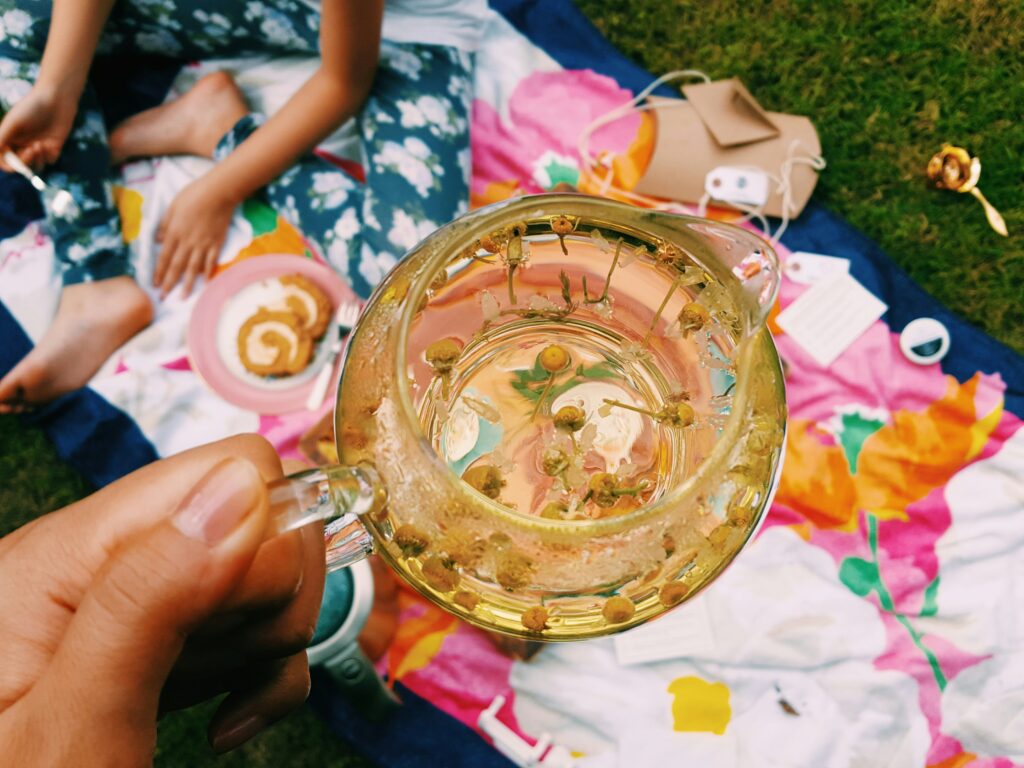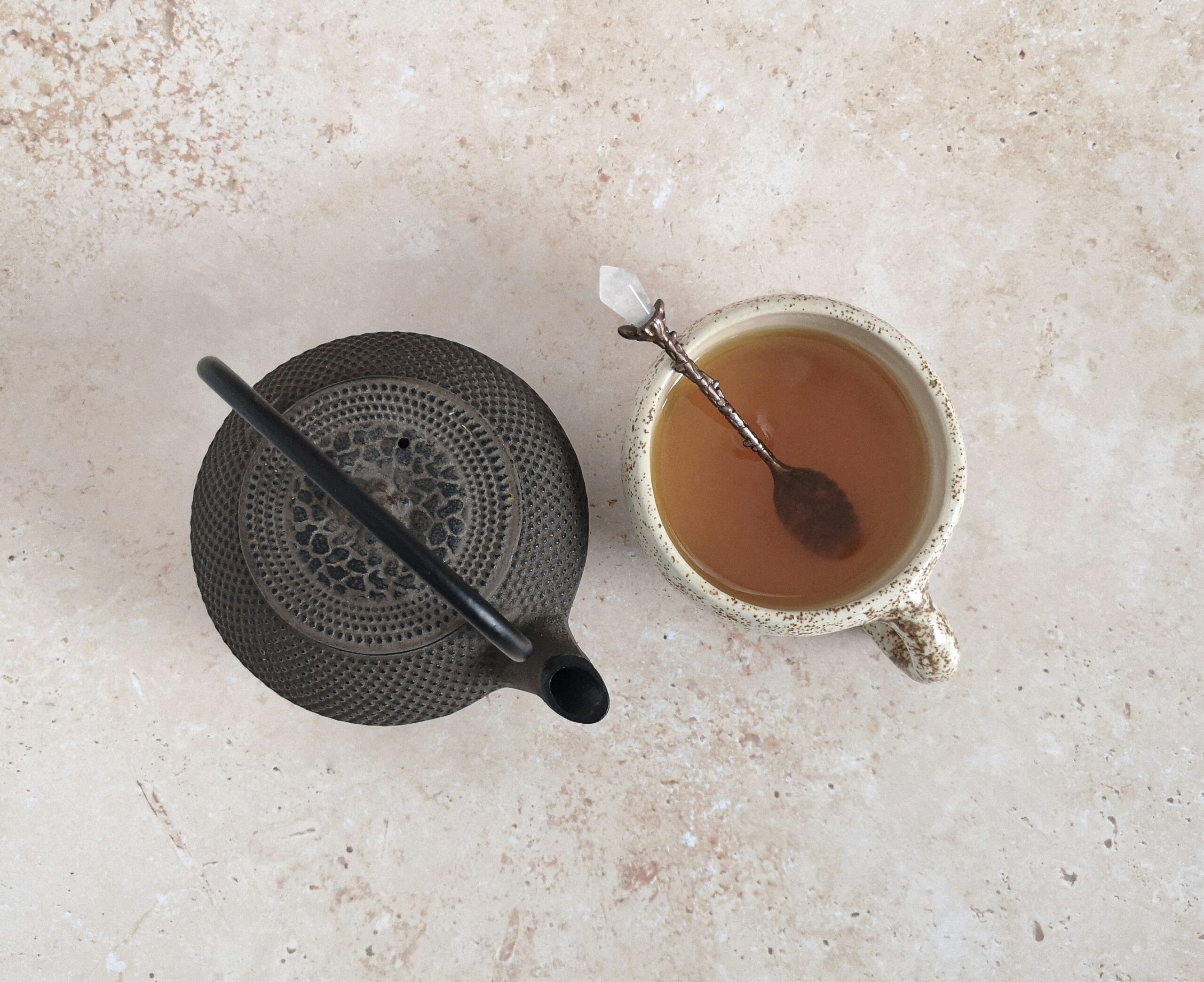
Wondering if herbal teas are caffeine-free? You’re in the right place. Yes, most herbal teas are naturally caffeine-free. Unlike black or green teas that come from the Camellia sinensis plant, herbal teas are often made from dried fruits, flowers, spices, or herbs.
This distinction makes herbal teas, or tisanes, a fantastic option if you’re avoiding caffeine. Popular ingredients include chamomile, peppermint, and rooibos. These blends can be enjoyed at any time of day without affecting your sleep.
Beyond the caffeine question, herbal teas also offer various health benefits and rich flavours. From soothing stomach issues to helping you relax, these infusions can be a delightful part of your routine.
Key Takeaways
- Most herbal teas are naturally caffeine-free.
- Herbal teas are made from a variety of herbs, flowers, and fruits.
- These teas offer unique health benefits and rich flavours.
SO WHAT ARE WE TALKING ABOUT TODAY?
- Understanding Herbal Teas
- Caffeine Content in Herbal Teas
- Health Benefits of Herbal Teas
- Popular Herbal Tea Ingredients
- Preparation and Brewing of Herbal Teas
- Cultural Significance of Herbal Teas
- Herbal Tea Varieties Around the World
- Safety and Considerations
- Environmental Impact of Herbal Tea Production
Understanding Herbal Teas
Herbal teas, also known as tisanes, are a popular alternative to traditional teas. While they share similar preparation methods, they differ in ingredients and properties. This section explores the definition and types of herbal teas and compares them to traditional teas made from the Camellia sinensis plant.
Definition and Types of Herbal Teas
Herbal teas are made from various herbs, flowers, fruits, and spices. Unlike traditional teas, they do not come from the Camellia sinensis plant. These blends do not contain caffeine and are known for their wide range of flavours and potential health benefits.
Common Types of Herbal Teas:
- Chamomile Tea: Often consumed for its calming effects.
- Peppermint Tea: Known for aiding digestion.
- Rooibos Tea: An antioxidant-rich option from South Africa.
- Hibiscus Tea: Recognised for its tart flavour and potential heart health benefits.
Each type of herbal tea offers unique properties, making them suitable for various preferences and needs.
Herbal Teas vs Traditional Teas
Traditional teas, whether black, green, or white, all come from the Camellia sinensis plant. These teas contain caffeine, which can provide a mild stimulant effect. Herbal teas differ as they are caffeine-free and derived from other plants, flowers, and spices.
Key Differences:
- Caffeine Content: Traditional teas contain varying levels of caffeine, whereas herbal teas are naturally caffeine-free.
- Ingredients: Traditional teas are made from Camellia sinensis, while herbal teas are made from a variety of plants.
- Flavour Profiles: Herbal teas offer diverse flavours depending on their ingredients, while traditional teas have a more consistent flavour range based on their oxidation levels.
Understanding these differences can help you choose the right tea based on your needs and preferences, whether you’re looking for an energising boost or a relaxing beverage.
RELATED: Best Herbal Tea For Energy: Top Choices To Boost Your Day
RELATED: Does Herbal Tea Stain Teeth? Uncovering The Truth For Your Smile
Caffeine Content in Herbal Teas
Herbal teas generally have little to no caffeine, making them popular among those looking to avoid this stimulant.
Naturally Caffeine-Free Options
Many herbal teas are naturally caffeine-free. For example, rooibos and honeybush herbal teas show no traces of caffeine. These South African teas are made from different plants than traditional teas, which is why they have no caffeine. Other herbal teas, like peppermint and chamomile, also have no caffeine and are made from herbs, flowers, and fruits.
Herbal teas such as peppermint and chamomile are good choices if you want to avoid the jittery side effects of caffeine. You can drink these teas any time of day without worrying about losing sleep. They provide a relaxing experience and can be enjoyed hot or cold.
Comparing Caffeine Levels
Sometimes, people compare herbal teas to decaf teas. It is important to note that decaffeinated teas often still have small amounts of caffeine, usually less than 12 mg per serving. In contrast, herbal teas like rooibos and honeybush naturally have zero caffeine.
Black, green, and oolong teas are made from the Camellia sinensis plant and have varying caffeine levels. Decaf versions of these are available, but they still contain minimal caffeine. Herbal teas, by their nature, avoid this issue altogether, making them ideal for those strictly avoiding caffeine.
Health Benefits of Herbal Teas
Herbal teas offer a range of health benefits, including strong antioxidant and medicinal properties, aiding sleep and relaxation, and supporting digestion and anti-inflammatory effects.
Antioxidants and Medicinal Properties
Herbal teas are rich in antioxidants. These compounds help protect your cells from damage caused by free radicals. Chamomile, for example, is well-known for its calming effects and may also contribute to immune system health. Peppermint tea is often used for its cooling and medicinal properties. These antioxidants can help in reducing oxidative stress and promoting overall health.
Rooibos tea, which is caffeine-free and high in antioxidants, is another popular choice. It is believed to support heart health and provide anti-ageing benefits. Mate tea, which contains some caffeine, still boasts a high antioxidant content, supporting both wellbeing and alertness.
Herbal Teas for Sleep and Relaxation
Many herbal teas are known for their calming properties, making them excellent choices for sleep and relaxation. Chamomile tea is often recommended as it can help you unwind and improve sleep quality. This tea can ease anxiety and promote better overall sleep.
Lavender tea is another popular option for relaxation. Known for its soothing scent, lavender can help reduce stress and improve relaxation. Valerian root tea is another choice for those needing help with sleep. It may act as a mild sedative, helping you to fall asleep more quickly.
Digestive and Anti-Inflammatory Effects
Herbal teas can support digestion and have anti-inflammatory effects. Peppermint tea is often used for digestive issues, such as bloating and gas. Its calming effects on the stomach muscles can help improve digestion and ease discomfort.
Ginger tea is widely known for its anti-inflammatory properties, making it a great choice for those suffering from inflammatory conditions. It can also help with nausea and improve digestion. Turmeric tea is another powerful anti-inflammatory herbal tea. It can support your immune system and help reduce inflammation throughout the body.
Oolong tea, although not entirely caffeine-free, is noted for its health benefits, such as helping in the management of Type 2 Diabetes and providing general health benefits through its antioxidant properties.
Each type of herbal tea offers unique benefits, making it possible for you to find one that fits your specific health needs and preferences.
Popular Herbal Tea Ingredients
Herbal teas are enjoyed for their unique flavours and beneficial properties. Here are some of the most popular ingredients used in herbal teas and their key benefits.
Chamomile and Mint
Chamomile is a favourite for its calming effects and mild flavour. Often used to promote sleep and relaxation, it’s a staple in many evening teas. Chamomile is also known for its anti-inflammatory and antioxidant properties, making it a popular choice for those seeking natural wellness.
Mint, especially peppermint, is another loved ingredient. It’s refreshing and can help with digestion. The menthol in mint provides a cooling sensation, making it soothing for the throat and stomach. You can also enjoy mint tea hot or cold, adding to its versatility.
Ginger and Turmeric
Ginger is well-known for its spicy kick and health benefits. It’s often used to soothe nausea and improve digestion. The warming quality of ginger tea makes it a great choice in colder months. Additionally, ginger has anti-inflammatory and antioxidant effects.
Turmeric is another powerhouse ingredient, recognised for its vibrant colour and earthy flavour. It’s used for its anti-inflammatory properties and is often paired with ginger to boost its effects. Turmeric tea can be a comforting drink that supports joint health and overall wellness.
Hibiscus and Rooibos
Hibiscus tea is vibrant red and has a tart flavour similar to cranberries. It’s rich in antioxidants and vitamin C, which can support your immune system. Hibiscus tea is often enjoyed cold, particularly in warmer weather, and can help manage blood pressure.
Rooibos is a South African herbal tea known for its rich, slightly sweet flavour. It’s caffeine-free and packed with antioxidants, making it a great choice for any time of day. Rooibos tea is also gentle on the stomach and can help with hydration due to its mineral content.
Each of these ingredients adds unique benefits and flavours to herbal teas, offering something special for everyone. Whether you’re looking for relaxation, digestive support, or a refreshing drink, there’s a herbal tea ingredient to suit your needs.
Preparation and Brewing of Herbal Teas
Herbal teas offer a wide variety of flavours and benefits. The way you prepare and brew these teas impacts their taste and effectiveness.
Brewing Techniques
Brewing herbal teas properly starts with selecting the right herbs. These can include chamomile, peppermint, and rooibos. Use around one teaspoon of dried herbs per cup of water.
Boil fresh water and pour it over the herbs. For a stronger flavour, let the herbs steep longer, typically for about 5-10 minutes. Covering the tea while it steeps helps to preserve the essential oils and full flavour.
Straining is the final step, ensuring that no leaves remain in your drink. You can use a fine-mesh strainer, infuser, or tea bag for this purpose.
Enhancing Flavours
You can enhance the flavour of herbal teas by adding natural ingredients. Honey is a popular sweetener that can provide a richer taste. Adding lemon can give a zesty tang, making the tea more refreshing.
Some people enjoy their herbal tea with a splash of milk. This works best with certain herbs like chamomile or rooibos. Another way to improve flavour is by blending different herbs together, such as mixing peppermint with lemon verbena for a refreshing blend.
Experimenting with the ratio of herbs to water can also adjust the strength of the flavour. Adjust amounts to find your perfect brew.
Cultural Significance of Herbal Teas
Herbal teas have held a special place in various cultures around the world for centuries. These teas are not just beverages but also part of traditional recipes and modern trends.
Herbal Tea in Traditional Recipes
In many cultures, herbal teas are part of daily life. For example, in China, tea ceremonies often include traditional herbs like chrysanthemum and ginseng. These herbs are believed to have health benefits. Each type of herbal tea has its significance and often relates to traditional medicine practices.
In Australia, indigenous communities also use native plants to make herbal teas. Plants like lemon myrtle and eucalyptus leaves have been used for their soothing properties. These teas are part of cultural rituals and traditional healing practices. You can see how herbal teas are deeply woven into the cultural fabric of many societies.
Modern Popularity and Trends
Today, herbal teas are popular worldwide. People drink them for various reasons, including health benefits, relaxation, and flavour. They are often caffeine-free, making them a preferred choice for people avoiding caffeine.
Trends show an increase in the variety of herbal teas available in stores and cafes. You might find exotic blends like hibiscus and elderflower or peppermint and liquorice. Even though they are rooted in tradition, these teas adapt to modern tastes and preferences, gaining new popularity each day.
Herbal Tea Varieties Around the World
Herbal teas come in many varieties and offer unique flavours and benefits. These teas are caffeine-free and can include ingredients like flowers, fruits, and spices.
African Red Teas and Chai
African red teas, also known as Rooibos, originate from South Africa. Rooibos tea is known for its deep red colour and slightly sweet, nutty flavour. It is made from the leaves of the Aspalathus linearis plant and contains no caffeine, making it a popular evening beverage.
Chai, commonly associated with India, also finds unique blends in Africa. African chai often includes spices like cinnamon, ginger, and cloves, blended with herbal ingredients for a rich and warming drink. These teas provide a robust flavour profile without the caffeine kick you might get from traditional teas.
Chinese Floral Teas and Fruit Infusions
Chinese floral teas are popular for their delicate tastes and aromatic properties. Jasmine tea, made by blending green tea leaves with jasmine flowers, is one of the most well-known. These types of teas are enjoyed not only for their flavour but also for their calming effects.
Fruit infusions from China often combine dried fruits like apple, pear, and berries with other herbal elements. These infusions are naturally sweet and packed with vitamins, making them a healthy, caffeine-free option for any time of the day. You might find blends that include hibiscus, which adds a tart flavour and a beautiful red hue to the tea.
Each variety of herbal tea brings its own set of flavours and benefits, offering something for everyone. Whether you prefer the earthy taste of Rooibos or the fragrant notes of jasmine, there’s a herbal tea out there for you.
Safety and Considerations
When choosing herbal teas, it is essential to be aware of potential allergies and safe consumption practices. Knowing how to consume herbal teas safely and recognising possible side effects can help you enjoy them without issues.
Allergies and Side Effects
Herbal teas can cause allergic reactions in some individuals. Common symptoms include rashes, itching, swelling, or difficulty breathing. Chamomile and echinacea are known to cause allergic reactions, especially for those allergic to plants in the daisy family.
Side effects vary depending on the herb. For example, green tea can cause stomach upset or headaches due to its caffeine content. Consuming large amounts of certain herbal teas like peppermint might lead to heartburn.
Always consult with a healthcare provider before starting any new herbal tea, particularly if you are pregnant, breastfeeding or taking medications. This step is crucial as herbal teas can interact with medications, altering their effects.
Safe Consumption Practices
Ensuring the safe consumption of herbal teas involves several practices. First, buy herbal teas from reputable brands to ensure they are pure and free from contaminants. Always follow the recommended steeping time and water temperature to avoid extracting harmful compounds.
Limit your intake of herbal teas that contain caffeine, like green tea, to avoid side effects like jitteriness or insomnia. For most people, consuming 2-3 cups of herbal tea per day is safe, but it is important to monitor how your body responds.
Store your herbal teas in a cool, dry place to maintain their quality and potency. If you notice any adverse reactions, stop drinking the tea and seek medical advice immediately.
Environmental Impact of Herbal Tea Production
The production of herbal teas can impact the environment in various ways, especially in terms of farming practices and harvesting methods. Sustainable approaches can help reduce these impacts and ensure eco-friendly cultivation.
Sustainable Farming and Harvesting
Sustainable farming practices are essential for reducing the environmental footprint of herbal tea production. These methods include crop rotation, organic farming, and using natural pest controls. By avoiding chemical pesticides and fertilisers, you help maintain soil health and protect local ecosystems.
Harvesting methods also play a key role. Hand-picking herbs reduces damage to the plants and the surrounding environment. Additionally, harvesting only the needed parts of the plants ensures they can continue to grow and produce.
Practises like these not only preserve the environment but also improve the quality of the herbal teas. Eco-friendly farming and harvesting methods are beneficial for both the planet and the end product.
Choosing the Right Herbal Tea for You
When choosing herbal tea, consider flavour profiles and therapeutic effects based on the ingredients to match your personal preferences.
Flavour Profiles and Pairings
Herbal teas come in a variety of flavours. Peppermint tea has a fresh, minty flavour that’s perfect for pairing with chocolate. Chamomile tea offers a slightly sweet, apple-like taste which goes well with honey.
Fruit-based herbal teas, like hibiscus and berry blends, provide a tart and tangy flavour, ideal for summer drinks. Rooibos tea, with its rich and slightly nutty taste, pairs nicely with vanilla. Consider these options to find a flavour that suits you.
Therapeutic Effects Based on Ingredients
Different herbal teas have various therapeutic effects. For relaxation, chamomile and lavender are popular choices. Peppermint tea may help with digestion.
Teas like ginger and turmeric can be soothing for colds and inflammation. Hibiscus tea might support heart health due to its high antioxidant content. Choose an herbal tea with ingredients that align with your health goals and personal needs.



Comments +